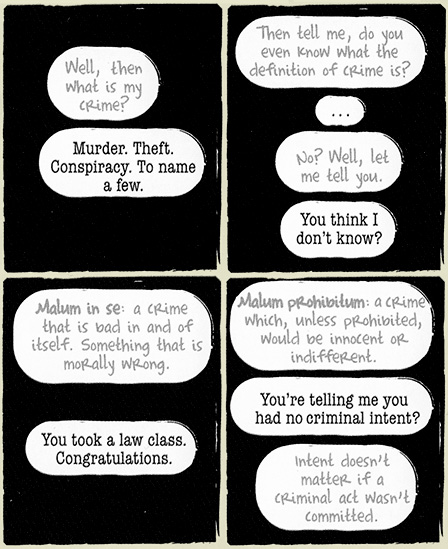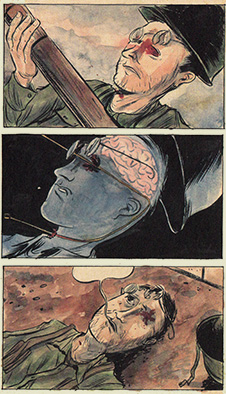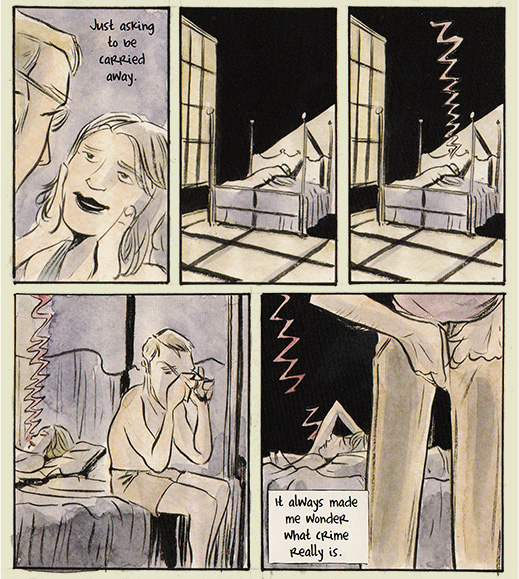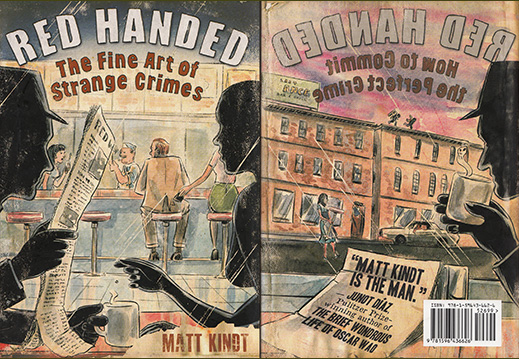Red Handed

On the back of Matt Kindt's Red Handed, there is a single endorsement for the book: "Matt Kindt is the man." Offered by Junot Diaz, one of the Third Millennium's first crop of kick-ass authors, we aren't given any context for whether this is just a general appraisal or if this was the summary of Diaz' remarkably elegant 2500-word discussion of Red Handed itself. I was a little suspicious (having been born in the early '70s and therefore in the tail-end cutoff for Generation X, suspicion is my natural state). Chalk it up to years of being lied to by marketing and media or maybe just to envy for the fact that Junot Diaz 1) hasn't declared me The Man and 2) likely is so unaware of who I am that point 1) is as likely as winning the lottery without playing. I thought "Matt Kindt is the man" was pretty weak so far as endorsements go. But then I asked my wife what she thought after she finished reading this book a few days ago. She basically reiterated Junot Diaz, albeit using completely different words:
"He's... he's some kind of genius, isn't he?"
And as it turns out, they're both right, Diaz and my wife. Kindt's mind twists and turns in a way that is perfectly in tune with the kind of narrative goodies he regularly delivers in his books. I first encountered Kindt's work with Super Spy, which stands shoulder-to-shoulder in a tie for my favourite piece of espionage fiction with John le Carré's The Spy Who Came in from the Cold. Ever since, I have never been disappointed with the magic he so carelessly weaves through his stories.
 Matt Kindt includes the inside of his head in this book.
Matt Kindt includes the inside of his head in this book.
While very different from Super Spy structurally,11In Super Spy, Kindt's framework presented the stories of twenty or so characters chopped up and dischronologized. It's only as you travel through the book that you begin to recognize that the stories of these spies aren't parts of a larger collection of short stories but bits and pieces of one larger tale. Red Handed does something similar in terms of taking several disparate threads and weaving them together into a satisfying whole. The stories of strange criminals start and stop, each concluding with the perpetrator being cuffed by the city's super detective, Gould. These are interleaved with artless sections of dialogue. It takes a while to apprehend the pattern—but when one does, it's hard not to stop and think "Heh" or "Little scamp" or "Whoa" in that kind of way that offers a silent congratulations to Kindt for letting us take part in this twisting genius.
Beyond the conceit of the Twist—that moment in the storytelling when the author turns the tables on the reader and turns the story they were reading into another story entirely—Kindt's structure for Red Handed allows him to effortlessly break off from his story and engage in a little bit of philosophical discussion about the nature of crime and law. Often in ambitious literary work, these excursions are narrative cheats that authors use to force-feed some added value into what would otherwise be a pretty mundane set of plot paces. While I was nervous for a time that Kindt had stepped into that common trap, Red Handed vindicates itself and Kindt uses these discussions to inform the story and enrich the reader's participation in its conclusion. In fact, Kindt's finale would be hollow without the ranging conversation that governs it.
 You know what else isn't a crime? Skateboarding.
You know what else isn't a crime? Skateboarding.
I haven't yet read Mind MGMT (though I'm looking forward to it22I've mentioned it elsewhere, but I no longer purchase comics in their individual chaptered form. Budgetary concerns combined with my lack of patience with serialization means that I only encounter comics stories through collections—and Mind MGMT's first collection is still a month off.), but of Kindt's other works I cannot decide between Super Spy and Red Handed as my favourite. Both are complex, valuable, and worth your time. It's possible that Red Handed may be the more ambitious. I don't know. I'll probably just have to reread both to make sure. And that's not an event I'll dread by any means. Matt Kindt is one of my favourite creators and I can't imagine a time when I stop anticipating what he'll produce next. Because: as it turns out this man really is some kind of genius, isn't he?
A Note about Perfection
While I think Red Handed is a good book, a great book, and maybe even a fantastic book, it is not a perfect book. What is really, I know, right? Still, while Kindt continues to hone his craft, I'd like to talk briefly about his path so far (as presently culminating for the moment in Red Handed).
Kindt, the some-kind-of-genius that he is, strikes me as foremost an Idea Man. Everything he's shown us so far paints him as prodigiously imaginative. He has big ideas for his overarching story, for the forms those stories take, and for some of the intricacies of how his pages and panels will lay out.33One instance on this last point. In 3 Story, Kindt draws a soldier being shot through the eye and uses the comics form to chart the path of the bullet through the topography of the man's head and neck. It was unnecessary but somehow adds to the reader's experience of his death.
(click for larger) I don't look for any improvement on his part in this area. He has, so far as I'm concerned, arrived. If not perfect for what he's doing, his ideas are close enough that we mere mortals cannot distinguish well enough to complain.
The area where I'd most like to see continued improvement is in the way he uses his art. Before even beginning down this road, I'd like to clarify that I think his art is good and great and enjoyable. With that, let me flesh this out just a tiny bit.
Kindt's art is indubitably unique to the current expression of the medium. He uses a kind of lumpy brushwork that allows him to stretch perspective and exaggerate anatomy such that he can engage in the kind of forced focus that his idea-play sometimes requires. With a crisper, more defined and realistic style, these visual ideas would break down and the reader would be distracted by the sort of uncanny-valley experience that naturally occurs by bending perspective. I love this about his art and the way he employs it. His style allows him to do things impossible for whole swaths of other creators.
The style does have a weakness, however, in that its looseness means interpreting panels can occasionally be difficult. There are times at which, because of the subject Kindt chooses to pursue, more detail is required in order to understand panel progression at a liquid speed with which readers are comfortable. Here's an example:

My presumption is that across these five panels we're meant to read a single chronological sequence. You have the man seducing the woman who then falls asleep and then into a deeper sleep and then he sits on the edge of the bed and then dresses. I think that's how we're to read it, but I'm not certain. There are issues with that reading. The chief problem is that in the two panels in which the woman sleeps and then sleeps more deeply (indicated by the stream of Zs incensing up from her head), the woman sleeps alone. The man is not present in the bed with her. Suddenly, he sits in underwear on bed's edge and presumably (under my interpretation) is putting on his glasses. In the next he is dressed, but the woman's position is changed and her elbow is elevated—not usually a position associated with deep sleep.
There are other possible interpretations for what's going on across those panels, but as a reader I'm not convinced that I should pursue trying to make those readings fit the revealed story because I can't be sure these inconsistencies aren't just part of the nature of Kindt's loose style. They do strike me as odd and prompt me to look for a non-sequential reading, but I'd prefer more visual cues to justify exploring that path.
So while I enjoy Kindt's art and style and use of those two expressions to breathe life into his stories, I guess I'd like to see more care in how he uses these things to tell his stories. I'd like to see him better govern what makes it into his panels, taking into account the strengths and weaknesses of his chosen style. He's not bad by any stretch. I'd just like to see improvement for the sake of clarity.
A Note about the Cover
It's easy to gloss over the design of dust jackets. Generally, they're simply meant to catch an eye and sell a book. Red Handed's cover may be intended for that purpose too, but what I like about it is the story it tells when one compares its front to its back. Specifically, on the frontside we see a woman slip a somethin-somethin' into a man's hot beverage while he reads the paper. On the rear we see the man about to sip from that same beverage and we are tipped by the death's head lifting from the drink's steamy vapour that the man's time will soon draw to a close. His companion is gone by this point and several minutes have passed, since on the front we see the chair-thief arguing with the cook (screwdriver in hand) and on the back we see her carrying her kidnapped barstool.
As well, the book's title and subtitle are presented as being part of the window of the diner in which the couple sits. On the front cover, the subtitle reads The Fine Art of Strange Crimes. On the rear and in reverse since our perspective has shifted to inside the diner, the subtitle changes to How to Commit the Perfect Crime.
None of this is a big deal. Just a bit of trivial fun.
Good Ok Bad features reviews of comics, graphic novels, manga, et cetera using a rare and auspicious three-star rating system. Point systems are notoriously fiddly, so here it's been pared down to three simple possibilities:
3 Stars = Good
2 Stars = Ok
1 Star = Bad
I am Seth T. Hahne and these are my reviews.
Browse Reviews By
Other Features
- Best Books of the Year:
- Top 50 of 2024
- Top 50 of 2023
- Top 100 of 2020-22
- Top 75 of 2019
- Top 50 of 2018
- Top 75 of 2017
- Top 75 of 2016
- Top 75 of 2015
- Top 75 of 2014
- Top 35 of 2013
- Top 25 of 2012
- Top 10 of 2011
- Popular Sections:
- All-Time Top 500
- All the Boardgames I've Played
- All the Anime Series I've Seen
- All the Animated Films I've Seen
- Top 75 by Female Creators
- Kids Recommendations
- What I Read: A Reading Log
- Other Features:
- Bookclub Study Guides











